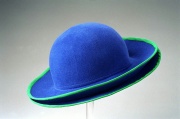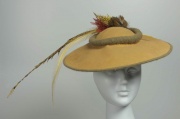Difference between revisions of "Angora"
(username removed) |
(username removed) |
||
| Line 31: | Line 31: | ||
== Authority == | == Authority == | ||
| − | * | + | * Hoechst Celanese Corporation, ''Dictionary of Fiber & Textile Technology'' (older version called Man-made Fiber and Textile Dictionary, 1965), Hoechst Celanese Corporation, Charlotte NC, 1990 |
| − | * | + | * Rosalie Rosso King, ''Textile Identification, Conservation, and Preservation'', Noyes Publications, Park Ridge, NJ, 1985 |
* Wikipedia, the free encyclopedia, at http://www.wikipedia.com Comment: http://en.wikipedia.org/wiki/Angora_rabbit (Accessed Oct. 18, 2005) | * Wikipedia, the free encyclopedia, at http://www.wikipedia.com Comment: http://en.wikipedia.org/wiki/Angora_rabbit (Accessed Oct. 18, 2005) | ||
| − | * | + | * G.S.Brady, ''Materials Handbook'', McGraw-Hill Book Co., New York, 1971 Comment: p. 388, 515 |
| − | * | + | * Random House, ''Webster's Encyclopedic Unabridged Dictionary of the English Language'', Grammercy Book, New York, 1997 |
* ''The American Heritage Dictionary'' or ''Encarta'', via Microsoft Bookshelf 98, Microsoft Corp., 1998 | * ''The American Heritage Dictionary'' or ''Encarta'', via Microsoft Bookshelf 98, Microsoft Corp., 1998 | ||
Revision as of 06:35, 24 July 2013
Description
The long, fine hair from an Angora rabbit. The silky hair from an Angora goat is sometimes called angora but more often called mohair. The Angora rabbit is native to Asia Minor, domesticated by the Trelicians since the 6th century, and only bred in Europe since the early 19th century. The white French rabbit produces high-quality, soft hair. The fur is trimmed every three months to produce clippings that are 3 inches long. Angora dyes readily, but is difficult to spin because of its fine texture. It is usually mixed with wool or other fibers for weaving cardigans and gloves. Angora does not felt like common rabbit hair.
Synonyms and Related Terms
angorakanin (Sven.); angora (Esp. Fr., Ned.)
Other Properties
Guard hairs are a dumbbell shape; diagonal scales with serrated edges
Fine hairs are oval; flattened scales with wavy edges
Hazards and Safety
Deteriorated by alkalis
Susceptible to mold, mildew and static electricity
Additional Images
Authority
- Hoechst Celanese Corporation, Dictionary of Fiber & Textile Technology (older version called Man-made Fiber and Textile Dictionary, 1965), Hoechst Celanese Corporation, Charlotte NC, 1990
- Rosalie Rosso King, Textile Identification, Conservation, and Preservation, Noyes Publications, Park Ridge, NJ, 1985
- Wikipedia, the free encyclopedia, at http://www.wikipedia.com Comment: http://en.wikipedia.org/wiki/Angora_rabbit (Accessed Oct. 18, 2005)
- G.S.Brady, Materials Handbook, McGraw-Hill Book Co., New York, 1971 Comment: p. 388, 515
- Random House, Webster's Encyclopedic Unabridged Dictionary of the English Language, Grammercy Book, New York, 1997
- The American Heritage Dictionary or Encarta, via Microsoft Bookshelf 98, Microsoft Corp., 1998



